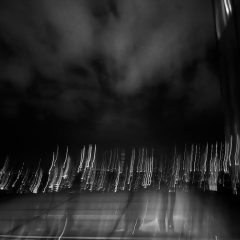
Stalker (Сталкер) 1979, Dir. Andrei Tarkovsky
Stalker (otherwise known as Сталкер) is Andrei Tarkovsky’s fifth feature film, it follows a guide (stalker), a writer, and a scientist. The guide leads the writer and the scientist to a place called ‘The Zone’. They escape from what looks like a wartorn, rundown, and military-dominated city to the zone which is the polar opposite. Complete solitude and silence and green scenery meanwhile their home is covered with a brown dusty tint. Within the zone, there is a room that supposedly grants any wish you can have. Throughout the film, we follow these 3 men and their conversations about their fears and what may lie in the zone.
Stalker is a beast of a movie, boasting a 2-hour and 41-minute runtime, but this movie (among other Tarkovsky films) utilises the runtime incredibly well and we left with a very meditative, thought-provoking, and intelligent movie.
The Sound
Stalker’s sound reminds me of a David Lynch quote “Sound is 50% of the film”. This is very much the case with Tarkovsky’s Stalker. Stalker uses sound in a very effective and thought-provoking way. Music is only heard for 17 minutes of this 161 minute movie. But the film feels very dense and full of sound when music is not playing. In his book Sculpting in time Tarkovsky talks about how he feels movies don’t need music at all. This is a common trait throughout Tarkovsky’s films as most of his films (including stalker) rely heavily on sound design than traditional music.
The composer/sound designer for Stalker is Eduard Artemyev. Artemyev is a Soviet/Russian composer who was a frequent collaborator of Tarkovsky. Creating the soundtrack/sound design for Solaris (1972), Mirror (1975), and Stalker (1979). Stalker was their last collaboration together. Much like Solaris and Mirror, what you hear in Stalker is primarily sound design. Artemyev doesn’t follow the traditional rules of diegetic and non-diegetic sound in Stalker. He challenges the viewer’s perception of what sound design is by doing something uncommon, this matches perfectly with the surreal atmosphere of Stalker.
For example, throughout the film, we see a few instances of fire being on screen. We see fire on screen we expect to hear the hiss of fire, and the crackling of firewood, but instead, we hear the sounds of water. One example of this is early on in the movie (9:30 mark), we see the character wash his hands and brush his teeth. There is a fire next to him. We never hear the sound of fire though, only the water that is coming out of the tap. He lights the fire with a match, but we only hear the match striking, we never hear the fire being lit. There is only one scene where the sound of fire is audible, they have a campfire at the 1:14:00 mark which is the sound of crackling firewood is audible. The use of water instead of fire seems like an intentional choice by Artemyev and Tarkovsky. Water is a recurring motif throughout stalker, with many scenes taking place in water or surrounding it.
Another interesting sound design choice happens at the 24:19 mark, A soldier is walking around looking for our protagonists who are escaping to the zone. The man walks to his motorcycle and as he is walking it sounds like a spring reverb being plucked, instead of the usual walking foley that would be used in most other movies.
Stalker really inspired me for its intentional minimalism, the score in the film is used sparingly and feels more impactful when used because the film is mostly sound design and foley. Tarkovsky and Artemyev treat sound design like it’s a part of the musical score which improves the film and the immersion of this world. My piece will be using primarily sound design with some traditional music elements. This film taught me to treat sound design like it’s apart of the overall score.
